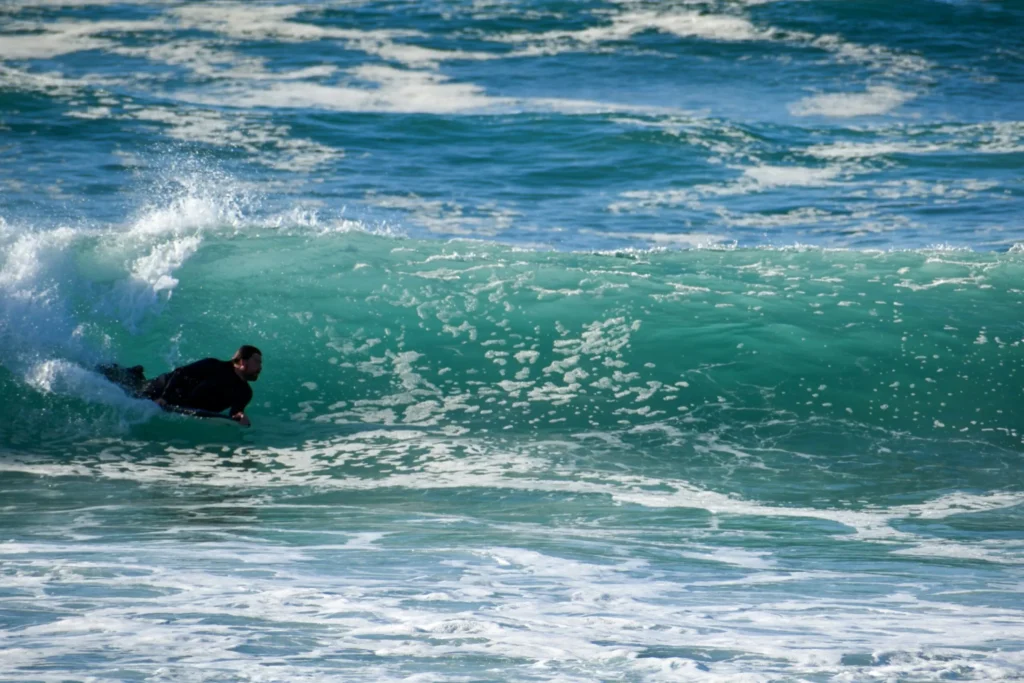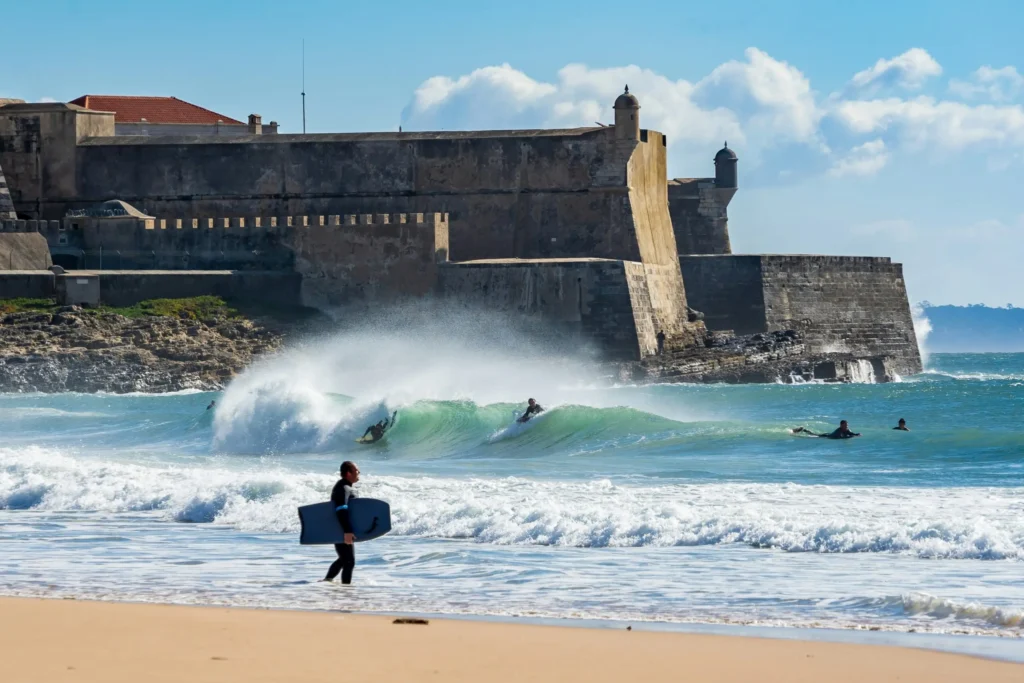Have you ever felt the rush of catching a perfect wave? Whether you’re standing up or lying down, the thrill is undeniable. But there’s a debate that’s been rippling through the surf community for years: Is bodyboarding really surfing?
You might have heard die-hard surfers dismissing bodyboarding as a lesser cousin of “real” surfing. But hold on to your board, because we’re about to dive into 7 compelling reasons why bodyboarding is absolutely a form of surfing. From the shared fundamental principles to the overlapping skill sets, you’ll discover that these two wave-riding disciplines are more alike than you might think.
So grab your fins and wax, because we’re about to ride through the similarities that unite bodyboarding and surfing. You’ll see why the line between these sports is as blurry as the horizon on a misty beach morning. Let’s paddle out and explore the shared world of wave riders!

Table of Contents
Riding the Waves: Same Fundamental Principle
When you compare bodyboarding and surfing, you’ll find that both sports share the same core principle: riding waves. This fundamental similarity is what makes bodyboarding undeniably a form of surfing. Let’s dive into the key aspects that demonstrate this shared foundation.
Harnessing Ocean Energy
As a bodyboarder, you harness the ocean’s energy in much the same way as a stand-up surfer. You position yourself to catch the wave, using your body and the board to tap into the wave’s power. This interaction with the ocean’s force is at the heart of both sports.
Reading and Anticipating Wave Patterns
Success in bodyboarding, like surfing, relies heavily on your ability to read and anticipate wave patterns. You need to:
- Observe the swell direction
- Assess wave height and shape
- Identify potential breaking points
This skill set is crucial for both bodyboarders and surfers, as it determines the quality and duration of your ride.
Positioning for Optimal Ride
Proper positioning is key to maximizing your bodyboarding experience, just as it is in surfing. Consider the following factors:
| Factor | Importance |
| Takeoff spot | Crucial for catching the wave |
| Body alignment | Affects speed and control |
| Weight distribution | Influences maneuverability |
By mastering these elements, you’ll enhance your ability to catch waves and perform tricks, whether you’re on a bodyboard or a surfboard.
As you can see, the fundamental principles of riding waves are virtually identical in bodyboarding and surfing. This shared foundation is a key reason why bodyboarding is indeed a form of surfing. Now that we’ve established this core similarity, let’s explore the equipment used in both sports.
Equipment Similarities
Now that we’ve established the fundamental principle shared by bodyboarding and surfing, let’s dive into the striking similarities in their equipment. You might be surprised to learn just how much these two water sports have in common when it comes to gear.
A. Board Design and Hydrodynamics
Both bodyboards and surfboards are designed with hydrodynamics in mind, ensuring optimal performance in the water. While they may differ in size and shape, you’ll find that both types of boards share key features:
- Rocker: The curvature along the length of the board
- Rails: The edges of the board that affect turning and control
- Bottom contours: Shapes that influence speed and maneuverability
| Feature | Bodyboard | Surfboard |
| Length | 38-45 inches | 5-12 feet |
| Material | Foam core with slick bottom | Foam core with fiberglass/epoxy |
| Shape | Rectangular with rounded nose | Pointed nose and tail |
B. Use of Fins for Control
You’ll find that both bodyboarding and surfing rely on fins to enhance control and maneuverability in the water:
- Bodyboarders wear swim fins on their feet
- Surfers have fins attached to their boards
In both cases, fins serve to:
- Increase propulsion
- Improve steering
- Enhance overall performance in the waves
C. Wetsuits and Beach Gear
When it comes to protecting yourself from the elements, you’ll use similar gear whether you’re bodyboarding or surfing:
- Wetsuits: Essential for temperature regulation in cooler waters
- Rash guards: Protect your skin from board abrasion and sun exposure
- Surf wax: Applied to boards for improved grip (though less common in bodyboarding)
- Beach essentials: Sunscreen, towels, and protective eyewear are must-haves for both sports
As you can see, the equipment used in bodyboarding and surfing shares many similarities, further reinforcing the close relationship between these two wave-riding disciplines. Next, we’ll explore the overlapping skill sets that make these sports even more alike than you might have thought.

Skill Set Overlap
Now that we’ve explored the equipment similarities between bodyboarding and surfing, let’s dive into the shared skill set that both sports require. You’ll find that many of the fundamental abilities needed for success in bodyboarding are also crucial in surfing.
Balance and Core Strength
As a bodyboarder, you rely heavily on your core strength and balance to maintain control on the waves. This is no different from surfing. In both sports, you need to:
- Engage your core muscles to stay stable
- Adjust your body position constantly
- Maintain balance while riding unpredictable waves
Timing and Wave Selection
Choosing the right wave and timing your ride is essential in bodyboarding, just as it is in surfing. You’ll need to develop:
- A keen eye for wave patterns
- The ability to read ocean conditions
- Quick decision-making skills
Paddling Techniques
While the paddling position differs between bodyboarding and surfing, the underlying principles remain the same. You’ll use similar techniques to:
| Paddling Skill | Bodyboarding | Surfing |
| Arm movement | Alternating strokes | Alternating strokes |
| Kick technique | Flutter kick | Leg kick for additional propulsion |
| Body position | Prone on board | Prone or kneeling on board |
By mastering these shared skills, you’ll find that your proficiency in bodyboarding can translate well to surfing, and vice versa. The overlap in these fundamental abilities demonstrates that bodyboarding is indeed a form of surfing, requiring similar expertise and physical prowess.
Shared Cultural Roots
Now that we’ve explored the similarities in equipment and skills, let’s dive into the shared cultural roots of bodyboarding and surfing. Both sports have a rich heritage that intertwines with the ocean and beach lifestyle.
Hawaiian Origins
Bodyboarding and surfing share a common birthplace: the beautiful islands of Hawaii. While surfing has ancient roots, bodyboarding emerged as a modern offshoot, embracing the same spirit of riding waves. You’ll find that both sports pay homage to the Hawaiian tradition of “he’e nalu” or wave sliding.
Beach Lifestyle
When you embrace bodyboarding or surfing, you’re not just picking up a sport – you’re adopting a lifestyle. Both communities share:
- A love for the ocean
- An appreciation for nature
- A laid-back, carefree attitude
- A passion for adventure
Respect for the Ocean
Perhaps the most significant cultural aspect shared by bodyboarders and surfers is their deep respect for the ocean. This reverence manifests in various ways:
| Aspect | Bodyboarding | Surfing |
| Environmental Awareness | Participating in beach cleanups | Supporting ocean conservation efforts |
| Safety | Understanding rip currents and wave patterns | Practicing proper etiquette in the lineup |
| Connection | Feeling at one with the waves | Experiencing the ocean’s raw power |
As a bodyboarder, you’ll find yourself part of a larger community that cherishes the ocean and its rhythms. This shared cultural foundation further cements bodyboarding’s place within the broader surfing culture. Next, we’ll explore how this cultural connection extends to competitive recognition in both sports.excellent choice for kids, beginners, or anyone looking to experience the thrill of wave riding without the steep learning curve of traditional surfing.

Competitive Recognition
Now that we’ve explored the shared cultural roots of bodyboarding and surfing, let’s dive into how both sports are recognized competitively. You might be surprised to learn just how similar the competitive landscapes are for these two wave-riding disciplines.
Professional Circuits and Tournaments
Both bodyboarding and surfing have well-established professional circuits that attract top athletes from around the world. Here’s a comparison of the major competitive events:
| Bodyboarding | Surfing |
| APB World Tour | World Surf League (WSL) Championship Tour |
| IBC World Tour | WSL Qualifying Series |
| Regional Championships | Regional Pro Junior Events |
As you can see, bodyboarding competitions mirror the structure of surfing events, providing athletes with similar opportunities for professional recognition and career advancement.
Scoring Systems
When it comes to judging performances, bodyboarding and surfing share remarkably similar scoring systems. Both sports typically use a scale of 0-10 points per wave, with judges evaluating:
- Wave selection
- Degree of difficulty
- Innovative and progressive maneuvers
- Combination and variety of maneuvers
- Speed, power, and flow
This parallel scoring approach underscores the competitive equivalence between bodyboarding and surfing, as athletes in both disciplines are judged on comparable criteria.
Trick Complexity and Style Points
You might think that surfing has the upper hand when it comes to trick complexity, but bodyboarding holds its own in this department. Both sports reward athletes for:
- Aerial maneuvers
- Tube riding
- Critical turns and spins
- Flow and style throughout the ride
In fact, bodyboarding often allows for even more radical maneuvers due to the board’s compact size and flexibility. This means that in competitive settings, bodyboarders can showcase an impressive array of tricks that rival the complexity and style of stand-up surfing.
As we move forward, you’ll see how the thrilling experiences in both sports contribute to their shared appeal and recognition in the world of water sports.
Thrilling Experiences in Both Sports
Now that we’ve explored the competitive recognition of bodyboarding, let’s dive into the exhilarating experiences shared by both bodyboarding and surfing.
Adrenaline Rush of Catching Waves
You’ll feel your heart racing as you paddle out to catch that perfect wave, whether you’re on a bodyboard or a surfboard. The anticipation builds as you position yourself, waiting for the right moment to make your move. When you catch that wave, the rush of adrenaline is unparalleled. Your body surges with excitement as you glide across the water’s surface, feeling the raw power of the ocean beneath you.
Connection with Nature
Bodyboarding, like surfing, offers you a unique opportunity to connect with nature. As you bob in the water, waiting for your next ride, you’ll feel a deep sense of harmony with the ocean. You’ll become attuned to the rhythm of the waves, the salt spray on your face, and the warmth of the sun on your skin. This intimate connection with the natural world is a core aspect of both sports, fostering a profound respect for the environment.
Sense of Freedom and Flow
When you’re riding a wave, whether on a bodyboard or a surfboard, you’ll experience an incredible sense of freedom and flow. Time seems to slow down as you become fully immersed in the moment. You’ll feel a state of effortless concentration, where your movements sync perfectly with the wave. This “flow state” is a key element that makes both bodyboarding and surfing so addictive.
Here’s a comparison of the thrilling experiences in bodyboarding and surfing:
| Experience | Bodyboarding | Surfing |
| Wave Riding | Close to the water, intense sensation | Standing, panoramic view |
| Maneuverability | Quick turns, spins, and flips | Carves, cutbacks, and aerials |
| Learning Curve | Generally easier to start | Steeper initial learning curve |
| Connection to Wave | Intimate, body-to-wave contact | Through the board, feet connection |
Whether you choose a bodyboard or a surfboard, you’re in for an exhilarating adventure that will challenge you physically and mentally while providing unforgettable moments in the ocean.
Next, we’ll explore the fascinating crossover between these two disciplines and how they complement each other.

Crossover Between Disciplines
The relationship between surfing and bodyboarding is more intertwined than you might think. Let’s explore the fascinating crossover between these two wave-riding disciplines.
Many Surfers Also Bodyboard
You’ll find that numerous surfers incorporate bodyboarding into their repertoire. This crossover isn’t just a coincidence; it’s a testament to the complementary nature of these sports. Many professional surfers, like Kelly Slater and John John Florence, have been known to grab a bodyboard when the conditions are right.
Transferable Skills
The skills you develop in one discipline often translate seamlessly to the other. Here’s a breakdown of some key transferable skills:
| Skill | Surfing | Bodyboarding |
| Wave Reading | Essential | Essential |
| Paddle Strength | Crucial | Important |
| Timing | Critical | Critical |
| Balance | Paramount | Significant |
As you can see, many of the fundamental skills overlap, making it easier for you to transition between the two sports.
Complementary Training Benefits
Engaging in both surfing and bodyboarding can offer you significant training advantages:
- Improved wave reading abilities
- Enhanced overall water skills
- Increased stamina and endurance
- Better understanding of ocean dynamics
By incorporating both disciplines into your water sports routine, you’ll become a more well-rounded wave rider.
Versatility in Various Wave Conditions
One of the most significant advantages of being proficient in both surfing and bodyboarding is the ability to adapt to different wave conditions. You’ll find that:
- Some waves are better suited for surfing
- Other waves are ideal for bodyboarding
- Certain conditions might be too dangerous for stand-up surfing but perfect for bodyboarding
This versatility allows you to make the most of any beach day, regardless of the conditions you encounter. With this adaptability, you’ll never have to miss out on a good day in the water.
Now that we’ve explored the crossover between surfing and bodyboarding, it’s clear that these disciplines are more closely related than many people realize. This connection further reinforces the idea that bodyboarding is indeed a legitimate form of surfing.
Bodyboarding is undeniably a form of surfing, sharing the same essence of riding waves and embracing the ocean’s power. From the fundamental principles of wave-riding to the overlapping skill sets and equipment similarities, bodyboarding and traditional surfing are more alike than different. Both sports have deep cultural roots, offer thrilling experiences, and are recognized in competitive arenas.
As you explore the world of wave-riding, remember that the lines between bodyboarding and surfing are often blurred. Whether you choose to stand up or lie down on your board, you’re part of the same vibrant community that cherishes the ocean. So grab your board, hit the waves, and enjoy the ride – because at the end of the day, it’s all about the joy of surfing, no matter how you do it.
